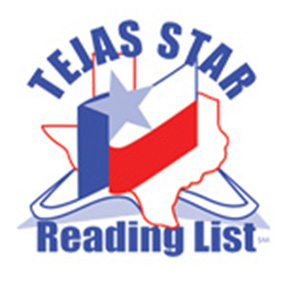by Priscilla Delgado, PhD student at St. John’s University, Tejas Star Reading List Committee Chair

The Tejas Star Reading List (TSRL) is an annual recommended reading list of Spanish and bilingual children’s books sponsored by the Texas Library Association. The purpose of the list is to encourage children ages 5-12 to explore multicultural books and to discover the cognitive and economic benefits of bilingualism and multilingualism.
The 2020-21 Tejas Star Reading List was recently released, featuring 24 exemplary Spanish and bilingual titles that include fiction and non-fiction picture books, chapter books, and graphic novels with themes of activism, environment, and identity, as well as stories of famous and important historical figures.
Several picture books on this year’s list are Spanish translations of bestselling English titles, including Chancho el campeón (Pig the Winner) by Aaron Blabey, El coleccionista de palabras (The Word Collector) by Peter H. Reynolds, Lola quiere un gato (Lola Gets a Cat) by Anna McQuinn, ¡Hola, Cangrejito! (Hello, Crabby!), and Señorita Mariposa by Ben Gundersheimer.
A variety of titles focus on our planet and outer space. Luciana: Misión submarina (Luciana: Braving the Deep) by Erin Teagan follows Luciana, the 2018 American Girl of the Year who aspires to be the first astronaut on Mars. Fuego, fueguito / Fire, Little Fire, a poetry book by Jorge Tetl Argueta, describes--in Spanish, English, and Nahuatl--the characteristics of fire from the perspective of one little spark. If you’ve ever wanted to learn more about the Titanosaur - the biggest, heaviest creature to walk on this planet, you’ll need to read Titanosaurio: El descubrimiento del dinosaurio más grande del mundo (Titanosaur: Discovering the World's Largest Dinosaur) by Dr. José Luis Carballido and Dr. Diego Pol. Mario y el agujero en el cielo: Cómo un químico salvó nuestro planeta (Mario and the Hole in the Sky: How a Chemist Saved Our Planet) by Elizabeth Rusch is a biography of Mexican-American scientist Mario Molina, who helped solve the ozone crisis of the 1980s.
The list features two additional biographies. Papa Francisco: Creador de puentes (Pope Francis: Builder of Bridges) by Emma Otheguy shares what life was like for Jorge Bergoglio as a boy growing up in Argentina before becoming Pope. Sembrando historias: Pura Belpré: bibliotecaria y narradora de cuentos (Planting Stories: The Life of Librarian and Storyteller Pura Belpré) by Anika Aldamuy Denise is a beautifully written book about the first Latina librarian employed at the New York Public Library and the namesake of the Pura Belpré Award that recognizes authors and illustrators whose works best portray the Latino cultural experience.
An innovative 5-book set, A lomo de cuento (A Storybook Ride) by Sergio Andricaín and Antonio Orlando Rodríguez, provides insight to numerous Latin-American countries and islands, including Argentina, Cuba, Mexico, Peru, and Puerto Rico. Each book explores the geography and culture as well as oral tradition and storytelling.
Two notable titles describe being uprooted from home, with two different plots but similar themes of hope. In Un nuevo hogar (A New Home) by Tania de Regil, a boy moving from New York City to Mexico City and a girl moving from Mexico City to New York City express their fears about leaving home to live in a new and unfamiliar place. Luca’s Bridge / El puente de Luca by Mariana Llanos is the emotional story of a boy coming to terms with his family's deportation from the United States to Mexico.
A few books encourage activism - speaking up and getting involved. Peter H. Reynold’s ¡Di algo! (Say Something!) explores the many ways that a single voice can make a difference. No dejes que desaparezcan (Don’t Let Them Disappear) by Chelsea Clinton profiles twelve endangered species around the world and describes why it is important to save each animal from extinction.
Graphic novels featured on this year’s list include Hombre Perro: El Señor de las Pulgas (Dog Man: Lord of the Fleas) by Dav Pilkey and Pangato: Soy yo. (Catwad: It’s Me.) by Jim Benton, two hilarious adventures.
The themes of identity and family are evident in some of the books on this year’s list. Mi papi tiene una moto (My Papi Has a Motorcycle) by Isabel Quintero is a touching story of a father and daughter with special memories of home. In ¿De dónde eres? (Where Are You From?) by Yamile Saied Méndez, after a young girl is asked where she's from--where she's really from--she turns to her grandfather for some help.
The Tejas Star Reading List committee will be presenting activities and resources to use with this year’s titles at the Texas Library Association conference on Wednesday, March 25, 2020, at 10:00 am. Make plans to attend to learn more about the reading list and to explore the TSRL activity guide with ready-to-use resources. The activity guide, as well as downloadable bookmarks and posters, will be available on our website: txla.org/tejas-star.



